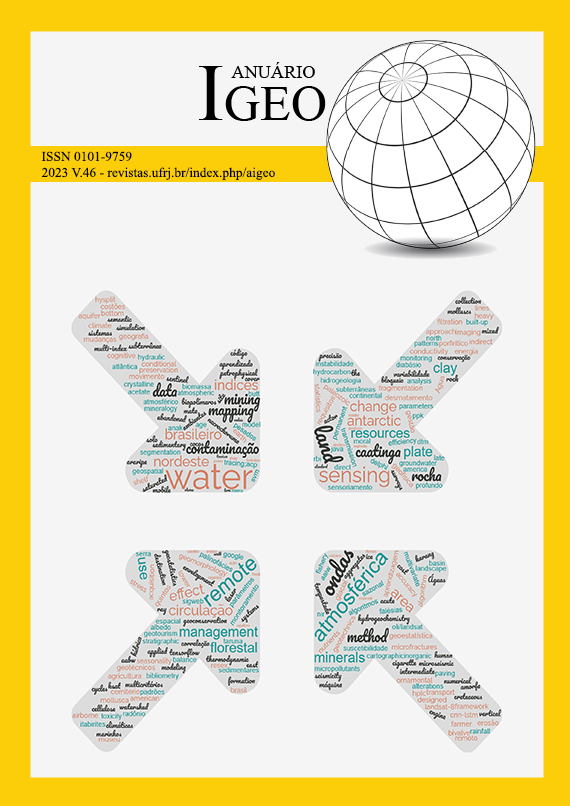The Role of Clay Minerals in the Petrophysical Properties of Carbonate Rocks from the Cotinguiba Formation (Sergipe-Alagoas Basin, Brazil)
DOI:
https://doi.org/10.11137/1982-3908_2023_46_48599Keywords:
Cretaceous carbonates, Rock porosity, Mineralogical analysesAbstract
The Cotinguiba Formation, of Cretaceous age, located in the Sergipe-Alagoas Basin, Brazilian Northeastern coast, comprises carbonate breccias and carbonate shales interlayered with fine to coarse clastic sediments (mudstones, marls), deposited in the maximum sea level episode during the Cenomanian-Coniacian transgressive event. Core sections were selected from the formation materials, from which 20 plugs were obtained, representing the main carbonate horizons present in Cotinguiba Formation. The selected samples were analyzed with petrophysical and physical methods (air porosimetry, mercury injection, and acoustic wave velocity) and mineralogical methods (optical microscopic analysis, x-ray diffraction (XRD) and scanning electron microscopy (SEM)). Results showed that the clay minerals’ content in the carbonates varies from 2% to 20%, with illites/micas and interstratified illite/smectite as the most abundant clay minerals, containing also traces of chlorite and kaolinite, and presence of palygorskite varying from trace to 8%. According to the percentages of calcite, dolomite, and siliciclastic + clay minerals obtained in the XRD analysis, the carbonates were lithologically identified as limestone, impure limestone, dolomitic limestone, impure dolomitic limestone, impure calcitic dolostone, and impure dolostone. The rocks have a good porosity, varying from 6% to 20% in the carbonates, predominantly related to microporosity. Clay minerals’ content influenced the grain density and acoustic properties, albeit not having the same role with porosity and permeability. SEM images, though, show that they have an important role in microporosity. Grain density variation related to phyllosilicate content was observed more significantly in impure limestones with a clay content higher than 8%, and a more pronounced decrease was observed in samples with palygorskite. Microporosity is the main factor for reducing Vp and Vs velocities in those carbonates, with values not exceeding 5341 m/s for Vp and 3026 m/s for Vs but, when clay content is higher than 4%, the Vp and Vs wave velocities do not exceed 4100 m/s and 2480 m/s, respectively. Therefore, the research allowed evaluating the influence of mineralogical and textural properties in the petrophysical properties of Cotinguiba Formation.
Downloads
References
Baechle, G.T., Eberli, G.P. & Weger, J. 2008, 'Effects of microporosity on sonic velocity in carbonate rocks', The Leading-Edge Special Section: Carbonates, vol. 27, no. 8, pp.1012-8, DOI:10.1190/1.2967554.
Bandeira Jr., A.N. 1977, 'Sedimentologia e microfacies calcárias das Formações Riachuelo e Cotinguiba da Bacia Sergipe/Alagoas', Dissertação de Mestrado, Universidade de São Paulo.
Campos Neto, O.P.A., Lima, W.S. & Cruz, F.E.G. 2007, 'Bacia de Sergipe-Alagoas', Boletim de Geociências Petrobrás, vol. 15, no. 2, pp. 405-15.
Cantrell, D.L. & Hagerty, R.M. 1999, 'Microporosity in Arab Formation Carbonates, Saudi Arabia', GeoArabia, vol. 4, no. 2, pp. 129-54.
Carbonate Advisor Schlumberger 2008, Quantitative producibility and textural analysis for carbonate reservoirs, viewed 05 Maio 2017, <https://www.slb.com/-/media/files/fe/brochure/carbonate-advisor-br>.
Coelho, A.A. 2020, TOPAS - Academic Technical Reference Version 7, Bruker-AXS, viewed 05 Maio 2017, <http://www.topas-academic.net/Technical_Reference.pdf>.
Eberli, G.P., Baechle, G.T., Anselmetti, F.S. & Incze, M.L. 2003, 'Factors controlling elastic properties in carbonate sediments and rocks', The Leading Edge, vol. 22, no. 7, pp. 654-60.
Feijó, F.L. 1994, 'Bacia de Sergipe e Alagoas', Boletim de Geociências Petrobrás, vol. 8, pp. 149-61.
Flügel, E. 2004, Microfacies of Carbonate Rocks. 2nd edn, Springer, Heidelberg.
Giannini, P.C.F. 2000, 'Depósitos e rochas sedimentares', in W. Teixeira, T.R. Fairchild, M.C. Toledo & F. Taioli (eds), Decifrando a Terra, Editora Oficina de Textos, São Paulo, pp. 301.
Hiller, S. 2000, 'Accurate quantitative analysis of clay and other minerals in sandstones by XRD: comparison of a Rietveld and a reference intensity ratio (RIR) method and the importance of sample preparation', Clay Minerals, vol. 35, no. 1, pp. 291-302.
Koutsoukos, E.A.M. 1989, 'Mid- to Late Cretaceous microbiostratigraphy, palaeo-ecology and palaeogeography of the Sergipe Basin, northeastern Brazil', Tese de Doutorado, University of Plymouth Research Theses.
Monteiro, R.S., Favoretto, J., Lopes, J.N. & Borghi, L. 2019, 'Análise Microfaciológica de uma Seção em Testemunho da Formação Cotinguiba, Cretáceo da Bacia de Sergipe-Alagoas', Geociências, vol. 38, no. 2, pp. 391-407, DOI:10.5016/geociencias.v38i2.12432.
Moore, D.M. & Reynolds, R.C. 1997, X-Ray Diffraction and the Identification and Analysis of the Clay Minerals, Oxford University Press, Oxford.
Morschbacher, M.J., Vasquez, G.F. & Justen, J.C.R. 2010, 'Metodologias de estimativa das velocidades sísmicas em ensaios de laboratório', 4º Simpósio Brasileiro de Geofísica, Brasília.
Schön, J.H. 2014, Propriedade Física das Rochas Aplicadas à Engenharia, São Paulo, Elsevier, São Paulo.
Spadini, A.R. & Marçal, R.A. 2005, 'Porosidade em reservatórios carbonáticos: algumas considerações', Boletim de Geociências da Petrobras, vol. 13, no. 1, pp. 129-38.
Toledo, P.G., Scriven, L.E. & Davis, H.T. 1994, 'Pore-Space Statistics and Capillary Pressure Curves from volume-controlled porosimetry', SPE Formation Evaluation, vol. 9, no. 1, pp. 46-54.
Zhou, X., Liu, D., Bu, H., Deng, L., Liu, H., Yuan, P., Du, P. & Song, H. 2018, 'XRD-based quantitative analysis of clay minerals using reference intensity ratios, mineral intensity factors, Rietveld, and full pattern summation methods: a critical review', Solid Earth Sciences, vol. 3, no. 1, pp. 16-29.
Downloads
Additional Files
Published
How to Cite
Issue
Section
License
This journal is licensed under a Creative Commons — Attribution 4.0 International — CC BY 4.0, which permits use, distribution and reproduction in any medium, provided the original work is properly cited.















